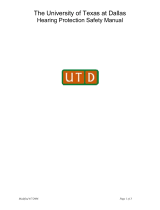Page is loading ...

With clean hands, roll
(don’t squeeze) the ear
plug between your thumb
and first 2 fingers until the
diameter of the plug is as
small as possible.
Reach over your head with
the opposite hand and pull
the top of your ear to open
the ear canal.
While you are holding the
ear open, quickly push the
rolled end of the plug into
your ear, leaving enough
of the ear plug outside the
ear to allow removal.
Here is the disposable ear
plug properly positioned in
the ear canal. For best fit,
at least 1/2 to 3/4 of the ear
plug should be inside your
ear canal.
Removing ear plugs: For
greater comfort, twist the
plug gently to break the seal
before removing the plug.
Fitting Instructions for
3M
TM
Hearing Protection
10004
page 1 of 2
3
Issue Date 01/01/04
1
2
4
3
1
2
4
3
Hold the stem of the ear
plug firmly behind the
largest flange.
Reach over your head with
the opposite hand and pull
the top of your ear to open
the ear canal.
Push the rounded tip of the
plug completely into your
ear canal, leaving the stem
of the plug outside the ear.
Here is the reusable ear
plug properly positioned in
the ear canal.
Removing ear plugs: For
greater comfort, twist the
plug gently to break the seal
before removing the plug.
Fitting your Foam Ear Plugs
before entering a hazardous noise area
Fitting your Reusable Ear Plugs
before entering a hazardous noise area

10004
page 2 of 2
3M
TM
Fitting Instructions for 3M
TM
Hearing Protection
Checking the fit of your Ear Plugs
1. Always fit your ear plugs so that they seal the ear closed. Once you put both plugs in, check the fit by
talking out loud. Your voice should sound hollow, as if you are talking in a barrel. The noises around
you should not sound as loud as they did before you put the plugs in.
2. Gently pull on the ear plug; it should not move easily. If the plug moves easily, remove it and re-insert
it deeper into the ear canal making sure that 1/4 of the plug is outside the ear.
3. Re-check the fit often during the time that you wear the ear plugs. If necessary, leave the hazardous noise
area and readjust the fit. If they become loose, you may lose your protection from noise.
4. The size and shape of each ear is unique. If you are unable to fit these ear plugs correctly and comfortably
in both ears, notify your supervisor or consider wearing a different size or type of hearing protection.
IMPORTANT
• Wear hearing protectors all the time that you are exposed to
loud noise. There is no such thing as “partial” hearing protection.
If you remove your ear plugs and subject your ears to loud noise
for just a few minutes out of an 8-hour shift, you will get much less
protection and may develop a hearing loss.
• Give yourself time to get used to wearing ear plugs. The
feeling of having plugs in your ears will become more familiar
after the first few times you wear them. You may want to switch
between ear plugs and ear muffs, gradually increasing the time
that you wear the plugs each day until you are comfortable
wearing ear plugs all the time.
•
Wear clean plugs. When foam plugs get dirty, replace them with
a clean pair. When reusable ear plugs get dirty, wash them with
mild soap and warm water, then rinse them well.
• Look closely at your ear plugs each time you wear them. Get
a new pair of foam ear plugs every day. Examine the ear plugs
before putting them in your ears. For both foam and reusable ear
plugs, if you see a tear or other damage, throw the plugs away
and get a new pair.
CAUTION
• Unless you have talked with your physician, do not wear ear
plugs if there is any drainage from your ear, or, if you have a
hole in your eardrum.
• Re-inserting dirty or soiled ear plugs into your ears may cause
discomfort and/or skin irritation in the ear canal. Do not use
hand creams or lotions immediately before rolling ear plugs and
inserting them into your ears, as these substances may damage
the ear plugs. Do not attempt to clean ear plugs with alcohol or
other disinfectants.
For more information, please contact:
3M Occupational Health and
Environmental Safety Division
(OH&ESD)
In the U.S., contact:
Sales Assistance
1-800-896-4223
Technical Assistance
1-800-243-4630
Fax On Demand
1-800-646-1655
Internet
http://www.3M.com/occsafety
For other 3M products
1-800-3M HELPS
In Canada, contact:
3M Canada Company, OH&ESD
P.O. Box 5757
London, Ontario N6A 4T1
Sales Assistance
1-800-265-1840, ext. 6137
Technical Assistance (Canada only)
1-800-267-4414
Fax On Demand
1-800-646-1655
Internet
http://www.3M.com/CA/occsafety
Technical Assistance In Mexico
01-800-712-0646
5270-2255, 5270-2119 (Mexico City only)
Technical Assistance In Brazil
0800-132333
Fax On Demand O.U.S. Locations
1-651-732-6530
• These hearing protection products help prevent hearing loss against certain noises. To provide proper protection,
the hearing protector should be (1) suitable for the job, (2) fitted properly in/on the ear, (3) worn during all times
of exposure to noise, (4) replaced when damaged or otherwise necessary.
• Failure to fit and use ear plugs according to these instructions will reduce their effectiveness. Failure to wear
hearing protectors 100% of the time that you are exposed to hazardous noise may dramatically increase your
risk of developing hearing loss.
• Keep ear plugs away from infants and small children. They may get caught in the child’s windpipe.
WARNING: HEARING PROTECTION PRODUCTS
!
3M Occupational Health and Environmental Safety Division
3M Center, Building 235-02-W-70
St. Paul, MN 55144-1000
/




